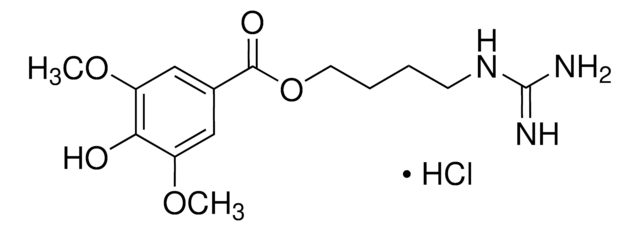SBR00029
Dansyl labeled polymyxin B Ready Made Solution
for fluorescent microbial imaging, 1.5 mg/mL in H2O
Synonyme(s) :
DSL-PMB, DSL-PMX, DSL-PxB
About This Item
Produits recommandés
Niveau de qualité
Forme
solution
Disponibilité
not available in China
Concentration
1.5 mg/mL in H2O
Couleur
colorless to light brown
Adéquation
suitable for (Fluorescent detection of gram-negative bacteria)
suitable for (Microbiome)
suitable for microbiology
Mode d’action
cell membrane
Conditions d'expédition
ambient
Température de stockage
−20°C
Description générale
Application
- as a fluorescent probe to study polymyxin mode of action and its pharmacokinetics
- in research and to develop new active derivatives of Polymyxin against multi-drug resistance Gram-negative infections
- to measure LPS binding affinity by fluorometric displacement assay
- Antimicrobial resistance research.
- Bacterial visualization and imaging.
- Parent antibiotic mode of action research and new antibiotic discovery.
- Toxicity studies.
- Research of bacterial infections and tracking its uptake in vivo.
Actions biochimiques/physiologiques
Caractéristiques et avantages
- High-quality antibiotic suitable for multiple research applications
- Ideal for Cell Biology, Metabolomics, and Biochemical research.
Remarque sur l'analyse
- Dansyl Labeled Polymyxin B Ready Made Solution is light sensitive.
- It is recommended to avoid freeze-thaw cycles of PMB-DSL Ready Made Solution.
- Dansyl Labeled Polymyxin B Ready Made Solution (1.5 mg/mL) can be diluted 1:50 in PBSX1 (Sigma#D8537) to achieve 30 μg/mL final concentration for staining. The above concentration of DSL-PMB was used for E. coli staining see image.
- Fluorescence Microscopy application: Dansyl Labeled Polymyxin B Ready Made Solution excitation (Ex) wavelength is 330-340nm resulting in emission (Em) range of 540-600nm (λmax=570nm).
Autres remarques
Code de la classe de stockage
12 - Non Combustible Liquids
Classe de danger pour l'eau (WGK)
WGK 1
Point d'éclair (°F)
Not applicable
Point d'éclair (°C)
Not applicable
Choose from one of the most recent versions:
Certificats d'analyse (COA)
Don't see the Right Version?
If you require a particular version, you can look up a specific certificate by the Lot or Batch number.
Déjà en possession de ce produit ?
Retrouvez la documentation relative aux produits que vous avez récemment achetés dans la Bibliothèque de documents.
Notre équipe de scientifiques dispose d'une expérience dans tous les secteurs de la recherche, notamment en sciences de la vie, science des matériaux, synthèse chimique, chromatographie, analyse et dans de nombreux autres domaines..
Contacter notre Service technique






